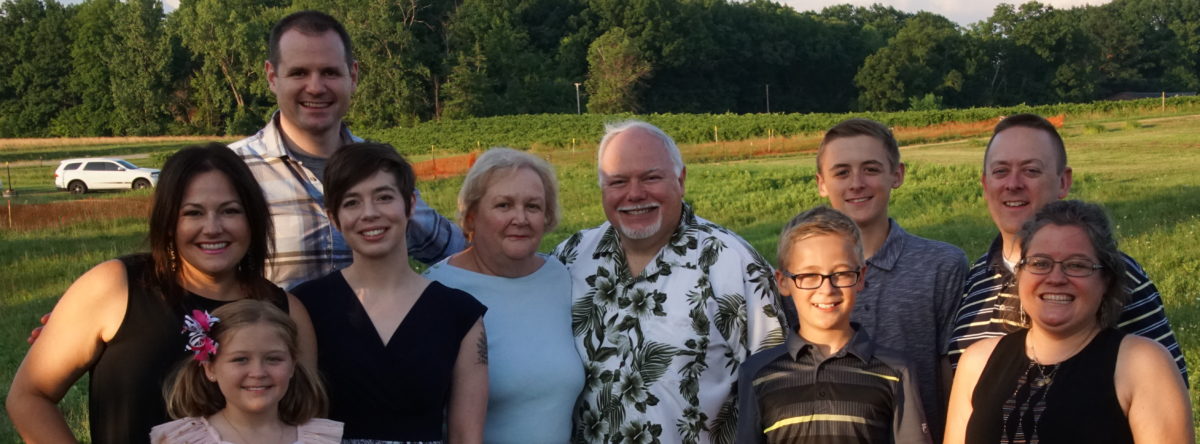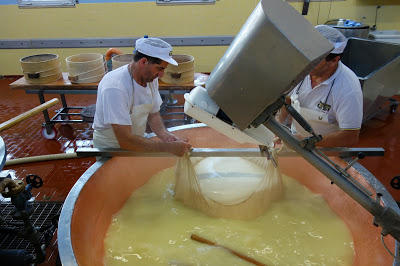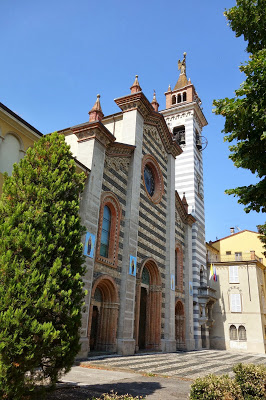Friday, September 20
Bettola is about an hour’s drive away from the region that produces what many consider the king of cheeses: Parmigiano-Reggiano. As the name suggests, Parmigiano-Reggiano is produced in two towns, Parma and Reggio Emila, and the area around them. We headed to Parma this morning to tour Consorzio Produttori Latte, one of the many caseificias that convert milk into Parmigiano-Reggiano cheese.
The process is pretty interesting to watch. Milk is cooked in a cone-shaped cauldron about three feet high. When the curds separate from the whey, they sink to the bottom. One of the cheesemakers uses a tool shaped like a canoe paddle to pull the curds away from the sides of the caldron. Meanwhile, his partner slips two corners of a cheesecloth underneath the ball of curds, and then the two of them pull the ball up from the bottom of the caldron and hang it from a metal rod spanning the top of the caldron.
This is a pretty big chunk of cheese: the final cheese will weigh about 70 pounds, so I’m guessing that with all the liquid in there the curds must weigh pretty close to 100 pounds.
The curds are placed in a form (hence the Italian word for cheese, formaggio), which presses a plastic ring into the side of the cheese to imprint the date, batch, serial number, etc. From there the cheeses go to a brine bath for a month. The brine bath leaches out the lactose in the cheese; I was surprised to learn that Parmigiano-Reggiano is lactose-free. Not surprisingly, the brine bath also adds salt to the cheese and toughens the rind: I had always assumed that Parmigiano-Reggiano had a wax or cloth skin, but the rind we see is simply a part of the cheese, and although it’s edible, it’s tough enough to protect the cheese.
“Parmigiano” is simply the Italian adjective for Parma; we, of course, say “Parmesan.” Evidently the cheese has been famous for a long time: I remember the British diarist Samuel Pepys detailing his efforts to save his “Parmazan” cheese from the Great London Fire of 1666 by burying it in his yard before evacuating. Christiana Capelli, our guide, made sure that we understood that not all “Parmesan” cheese is Parmigiano-Reggiano, and of course that message is one of the reasons why they make these tours available. We enjoyed the samples they offered before we left, and visited their store to purchase some gifts and mementos. After our immersion a few days earlier in the life of ancient Rome and the treasures of the Vatican, it made a fascinating look at an everyday product of our own times.
With a stop for coffee on the way back, we spent the rest of the day in Bettola. We arrived pretty close to siesta time, which gave us an opportunity to look over the lovely town square. A statue of Cristoforo Colombo occupies one end of the town square, and a fountain occupies the middle. One side has a café, the municipio (town hall), and a tabacchi (the ubiquitous “tobacco” shop, carrying everything from prepaid cellular minutes to candy to post cards to actual tobacco). On the opposite side and dominating the square is the parish church.
The church is referred to as the Sanctuario di Santa Maria della Quercia: the Sanctuary of St. Mary of the Oak. The name refers to a 1496 apparition of the Blessed Virgin to shepherds at an oak tree near Bettola. If I understand the Italian correctly, the present church dates to 1954, but the list of pastors on the wall goes back to 1828, including the pastor who would have baptized my great-great-grandfather. The campanile (bell tower–seems like all the churches here have one) bears large letters reading Ai caduti della Valnure–“To the fallen of Valnure.” Valnure, the Nure Valley, is the name of the geographical area that includes Bettola. We sometimes forget that 70 years ago, we were at war; we would occasionally see reminders like this.
Evidently, this a church still has a congregation; signs of current worship are everywhere, although I didn’t see an organ or any other instrument. The sanctuary has a golden niche to hold a statue of the Blessed Virgin, when she isn’t out in the church closer to the parishioners, as she was for our visit. You can see her on the right side in the photo below.
We went for lunch at Ristorante Agnello, a few doors down from the church, joined by Francesco and his mother, Maria Luisa. We think that they are related through the Costas, one of the many branches of our family formed through the dozens of marriages over the years. As we sat in the outdoor café area, Bianca Lavezzi, a Bettola expatriate who spends most of her year in England and part of the year at her apartment across the square from where we were sitting. We chatted with Bianca for just a few moments–she was on her way to a meeting with her attorney, who has an office near the restaurant.
We had visited Francesco’s Vecchia Stazione the night before, and we stopped there briefly to meet his father. At their recommendation, we headed off to Grazzano Visconti, a reconstructed medieval fortress about halfway between Bettola and Piacenza. According to Wikipedia, it dates to 1395 and was somewhat restored in the early 20th century. Today it is perhaps most notable for its shops, but it was fun to walk around the grounds and see some of the exhibits.
We stopped at the Vecchia Stazione one more time for some snacks and drinks, and then it was time to head back to Villa Enrichetta for the usual late dinner. We had Francesco call ahead and explain to GiamPier that we would need a lighter dinner than usual. That proved to be a good move: we made do with only a single pasta dish and the usual salume (plate of cold cuts) this evening, and we left the table a bit less overloaded than on some of the previous evenings.
Tomorrow we plan to settle our accounts, take a few more pictures on the town square, and then head to Genoa.



